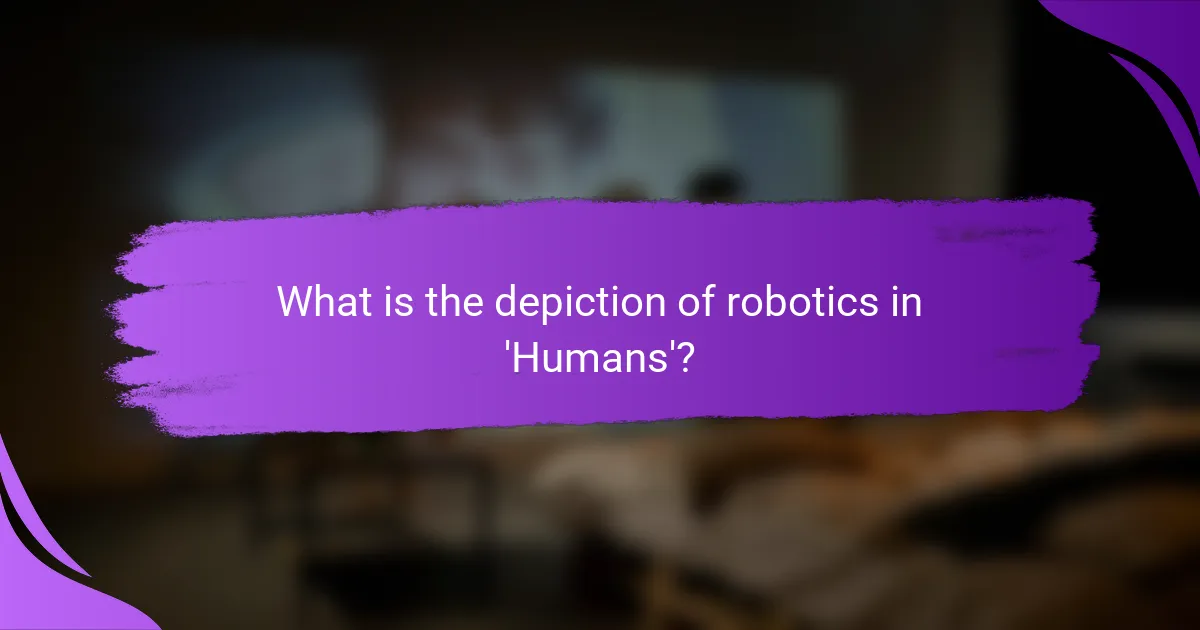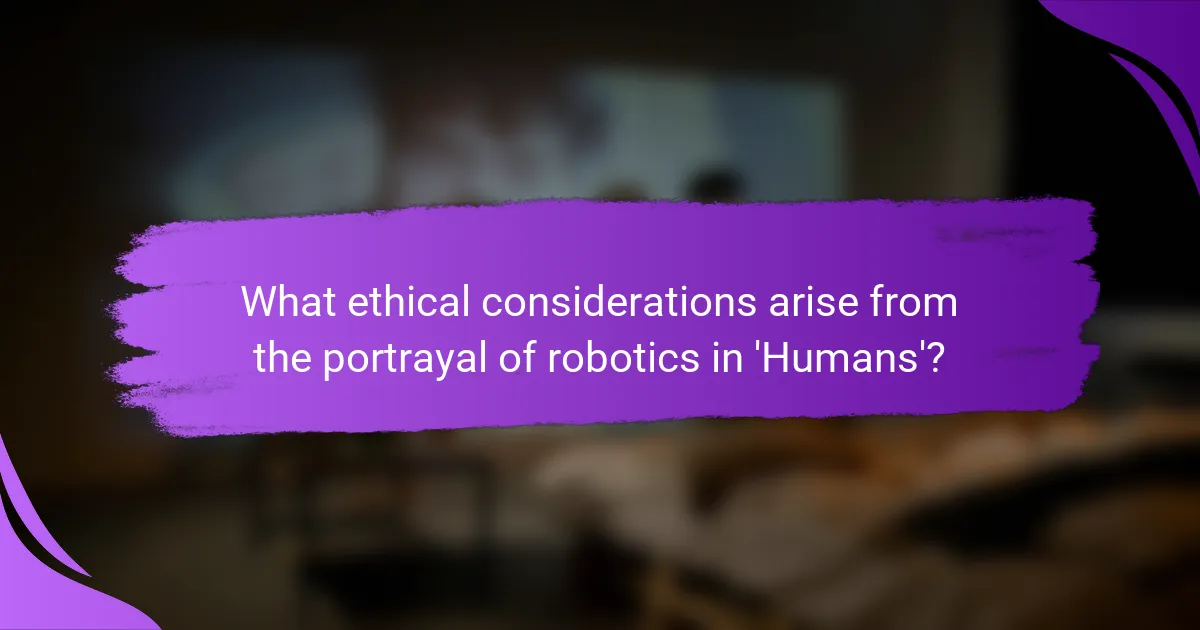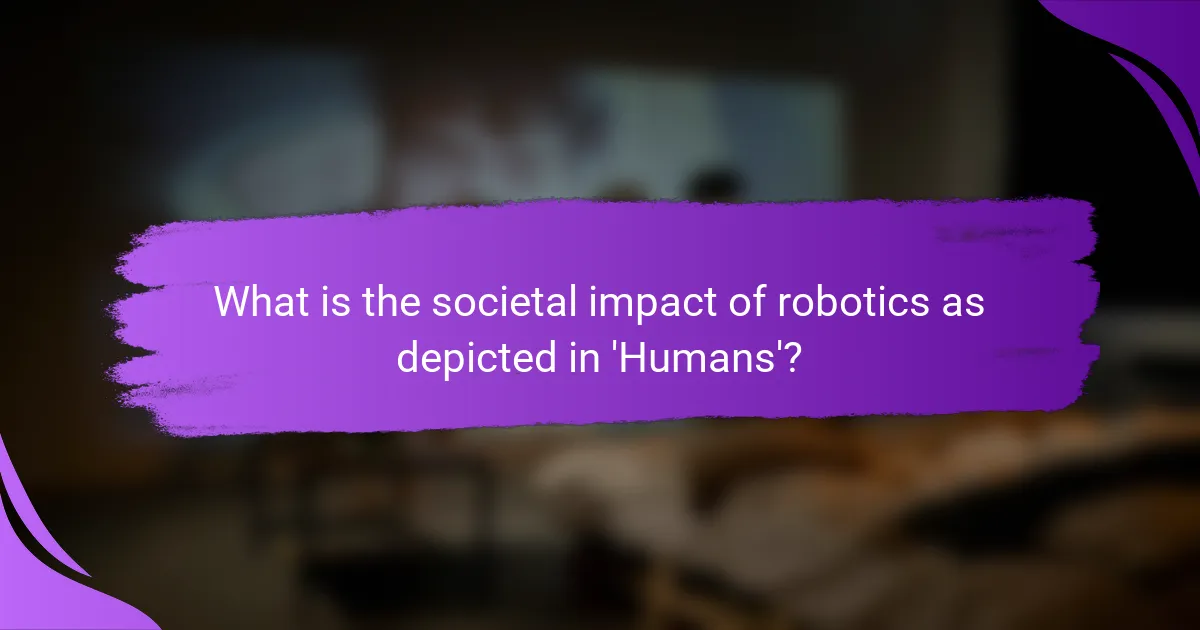The article explores the depiction of robotics in the television series ‘Humans,’ which features advanced synthetic beings known as Synths. These Synths are designed to resemble humans and serve various roles, raising significant emotional and ethical questions about their consciousness and rights. The narrative highlights societal tensions, including discrimination and the impact of Synths on employment and human relationships. Key themes include the moral implications of using robots for companionship and labor, as well as the potential for societal division regarding technology adoption. The discussion reflects broader real-world conversations about AI ethics and the future of human-robot interactions.

What is the depiction of robotics in ‘Humans’?
The depiction of robotics in ‘Humans’ portrays highly advanced synthetic beings called Synths. These Synths possess human-like appearances and capabilities. They are designed to serve humans in various roles, such as domestic helpers and caregivers. The series explores the emotional and ethical implications of Synths gaining consciousness. It raises questions about their rights and the moral responsibilities of their creators. The narrative highlights societal tensions between humans and Synths. This includes fear, prejudice, and the struggle for acceptance. Overall, ‘Humans’ presents a complex view of robotics, emphasizing both technological advancements and ethical dilemmas.
How are robots characterized in the series ‘Humans’?
In the series ‘Humans,’ robots, referred to as Synths, are characterized by their human-like appearance and advanced artificial intelligence. They are designed to serve humans in various domestic and labor roles. Synths exhibit emotions and can form relationships, blurring the lines between artificial and human experiences. The show explores themes of consciousness and free will among these robots. Their interactions with humans raise ethical questions about autonomy and rights. The series illustrates the societal impact of integrating robots into daily life. Synths are portrayed as both beneficial and potentially threatening to human society. This duality highlights the complexities of human-robot relationships in a technologically advanced world.
What attributes define the robots in ‘Humans’?
The robots in ‘Humans’ are defined by their advanced artificial intelligence, physical appearance, and emotional capabilities. These robots, known as Synths, possess human-like features and are designed for domestic and personal assistance. They exhibit learning abilities, allowing them to adapt to their environment and user preferences. Synths can express emotions and respond to human cues, blurring the lines between machine and human interactions. The show explores ethical implications of their sentience and the societal impact of integrating such robots into daily life. The portrayal raises questions about identity, autonomy, and the moral responsibilities of creators.
How do these characteristics compare to real-world robotics?
The characteristics depicted in ‘Humans’ often exaggerate the capabilities of real-world robotics. For instance, the show presents robots with advanced emotional intelligence and human-like consciousness. In contrast, current robotics primarily focus on task-specific functions without genuine emotional understanding. Real-world robots, such as those used in manufacturing, operate on programmed algorithms and lack self-awareness. Furthermore, the ethical dilemmas shown in ‘Humans’ are speculative, as real robotics face more practical concerns like safety and efficiency. Research indicates that while robots can mimic certain human behaviors, they do not possess true empathy or consciousness, as highlighted in studies by the MIT Media Lab.
What technological advances in robotics are showcased in ‘Humans’?
‘Humans’ showcases advanced robotics through the depiction of synthetic beings called Synths. These robots exhibit human-like intelligence and emotional responses. They are designed to perform household tasks and provide companionship. The show highlights developments in artificial intelligence, enabling Synths to learn and adapt. Additionally, it explores the ethical implications of creating sentient beings. The emotional depth of the Synths raises questions about rights and personhood. The series illustrates the potential for robotics to integrate into daily life. Overall, ‘Humans’ presents a nuanced view of technological advancements in robotics.
Which specific robotics technologies are highlighted in the series?
The series highlights several specific robotics technologies. These include humanoid robots designed for companionship and assistance. The robots possess advanced artificial intelligence for natural language processing. They also feature sophisticated sensors for environmental interaction. Additionally, the series showcases robotics technologies that enable emotional recognition. This includes [censured] recognition capabilities to gauge human emotions. The portrayal emphasizes the impact of these technologies on human relationships. Overall, the series illustrates both the potential and ethical dilemmas of advanced robotics.
How do these technologies reflect current trends in robotics?
Current technologies in robotics, such as artificial intelligence and machine learning, reflect trends toward automation and enhanced human-robot interaction. These advancements enable robots to perform complex tasks autonomously. For example, AI algorithms allow robots to learn from their environments and improve their performance over time. The trend of collaborative robots, or cobots, showcases a focus on safety and teamwork with human workers. Furthermore, developments in soft robotics highlight a shift toward creating more adaptable and safe robots for various environments. Statistics indicate that the global robotics market is expected to grow significantly, reaching over $500 billion by 2025. This growth underscores the increasing integration of robotics in industries like manufacturing, healthcare, and service sectors.

What ethical considerations arise from the portrayal of robotics in ‘Humans’?
The portrayal of robotics in ‘Humans’ raises several ethical considerations. One major concern is the treatment of synthetic beings as sentient entities. The show prompts viewers to question the moral implications of using robots for labor and companionship. Another ethical issue is the potential for exploitation, as characters in the series often face discrimination and abuse. Privacy and data security are also highlighted, as robots collect personal information. Additionally, the series explores the impact of robotics on human relationships and social dynamics. These themes reflect real-world discussions in AI ethics and robotics. The portrayal in ‘Humans’ serves as a cautionary tale about the future of human-robot interactions.
How does ‘Humans’ address the morality of artificial intelligence?
The series “Humans” addresses the morality of artificial intelligence by exploring the ethical dilemmas surrounding synthetic beings. It portrays the moral implications of creating sentient machines. The show raises questions about the rights of AI and their treatment by humans. Characters grapple with the consequences of their actions towards these beings. The narrative highlights the potential for exploitation and abuse of AI. It also examines the emotional connections formed between humans and machines. The series presents scenarios where AI challenges human moral frameworks. Through these storylines, “Humans” encourages viewers to reflect on the future of AI ethics.
What ethical dilemmas are presented through robot characters?
Robot characters present ethical dilemmas primarily concerning autonomy, rights, and moral responsibility. These dilemmas arise when robots exhibit human-like traits, leading to questions about their treatment and status. For instance, if a robot can feel pain or emotions, should it be granted rights similar to humans? Additionally, the issue of accountability emerges when robots make decisions that result in harm. Who is responsible for those actions: the creator, the user, or the robot itself? The portrayal of robots in media, such as the series “Humans,” highlights these ethical concerns, prompting viewers to consider the implications of advanced robotics in society.
How do these dilemmas relate to contemporary debates on AI ethics?
The dilemmas presented in ‘Humans’ directly relate to contemporary debates on AI ethics. These dilemmas highlight issues such as autonomy, consent, and the moral status of AI entities. For instance, the portrayal of sentient robots raises questions about their rights and treatment. Ethical frameworks must address the implications of creating beings with human-like consciousness. Additionally, the series prompts discussions on the responsibilities of creators in ensuring ethical AI development. As AI technology advances, these ethical considerations become increasingly relevant in policy-making and societal norms. The ongoing discourse emphasizes the need for clear guidelines to navigate the complexities of AI ethics.
What implications does the series suggest regarding human-robot relationships?
The series suggests that human-robot relationships can lead to complex emotional connections. It portrays robots as entities capable of developing personalities and emotions. This raises ethical questions about consent and autonomy. The interactions between humans and robots challenge traditional notions of relationships. Characters in the series often form attachments to robots, blurring the lines between companionship and servitude. This reflects societal concerns about dependency on technology. The series also hints at potential conflicts arising from these relationships. Overall, it emphasizes the need for careful consideration of the implications of integrating robots into daily life.
How are emotional connections between humans and robots portrayed?
Emotional connections between humans and robots are portrayed as complex and multifaceted. In the series “Humans,” robots, known as Synths, exhibit human-like emotions and behaviors. This portrayal raises questions about the nature of consciousness and empathy. The Synths develop attachments to humans, reflecting a deepening bond. For instance, characters form friendships and familial ties with their Synths. This blurs the line between human and machine interactions. The series explores the ethical implications of such connections. It challenges viewers to consider the emotional capacity of artificial beings. This depiction reflects ongoing societal debates about technology and human relationships.
What societal impacts are implied through these relationships?
The societal impacts implied through the relationships in ‘Humans’ include shifts in labor dynamics and emotional connections. Robotics can replace human jobs, leading to unemployment and economic disparity. The portrayal of robots as companions raises questions about human relationships and emotional dependencies. This can alter social structures and redefine what it means to connect with others. Additionally, ethical dilemmas arise regarding autonomy and rights of robots. As technology advances, society must navigate these complexities to ensure equitable outcomes. The series reflects on these themes, prompting discussions about the future of human-robot interactions.

What is the societal impact of robotics as depicted in ‘Humans’?
The societal impact of robotics as depicted in ‘Humans’ includes significant changes in employment, relationships, and ethical dilemmas. Robotics leads to job displacement as synths replace human workers in various sectors. This creates economic challenges for those unable to adapt to new job markets. Relationships between humans and synths complicate traditional social structures. Emotional attachments to synths raise questions about the nature of consciousness and empathy. Ethical dilemmas arise regarding the rights of sentient machines. The series illustrates the potential for societal division between those who embrace technology and those who resist it. Overall, ‘Humans’ presents a complex view of how robotics can reshape society.
How does ‘Humans’ reflect societal fears and hopes about robotics?
The series ‘Humans’ reflects societal fears and hopes about robotics through its portrayal of synthetic beings. The show presents advanced robots, called Synths, that evoke both admiration and fear. Societal hopes are illustrated by the Synths’ potential to enhance human life, improve productivity, and provide companionship. Conversely, fears emerge from the potential loss of jobs, ethical dilemmas, and the threat of rebellion. The narrative explores how humans interact with Synths, revealing deep-seated anxieties about autonomy and control. The emotional connections formed between humans and Synths highlight a longing for companionship, while also raising questions about identity and humanity. Overall, ‘Humans’ serves as a mirror reflecting contemporary societal debates surrounding the integration of robotics into daily life.
What specific societal issues are raised in the narrative?
The narrative raises specific societal issues such as the ethical implications of artificial intelligence. It questions the morality of creating sentient beings for servitude. The story explores themes of identity and humanity in relation to robots. It highlights the potential for social inequality between humans and robots. The narrative also addresses the fear of job displacement due to automation. Additionally, it presents the challenge of consent and autonomy for sentient machines. These issues reflect broader concerns about technology’s role in society. The portrayal of robotics in the narrative prompts critical discussions on the future of human-robot relationships.
How does the series influence public perception of robotics?
The series ‘Humans’ significantly influences public perception of robotics by humanizing robots and presenting them as relatable entities. This portrayal encourages viewers to empathize with robotic characters, shaping their understanding of artificial intelligence. The series addresses ethical dilemmas, prompting discussions about the implications of robotics in society. By showcasing both the benefits and dangers of advanced robotics, it fosters a balanced perspective among audiences. Research indicates that media representations can alter public attitudes towards technology. For instance, studies have shown that empathetic portrayals can lead to increased acceptance of robotic integration in daily life. This influence is crucial as it shapes societal norms and expectations regarding future technological advancements.
What lessons can be learned from the depiction of robotics in ‘Humans’?
The depiction of robotics in ‘Humans’ teaches important lessons about human-robot relationships. It illustrates the potential for emotional connections between humans and robots. The show highlights ethical dilemmas surrounding artificial intelligence and autonomy. It raises questions about the rights of sentient beings. The portrayal of robots as companions reflects societal anxieties about technology. It also emphasizes the need for responsible innovation in robotics. The series suggests that understanding and empathy are crucial in human-robot interactions. Overall, ‘Humans’ prompts viewers to consider the implications of advanced robotics on society.
How can the series inform real-world discussions about robotics?
The series can inform real-world discussions about robotics by highlighting ethical dilemmas and societal impacts. It presents scenarios where artificial intelligence interacts with human emotions and relationships. This encourages viewers to reflect on the implications of integrating robots into daily life. The series illustrates potential benefits, such as increased efficiency and assistance in various tasks. It also raises concerns about privacy, autonomy, and job displacement. By dramatizing these issues, the series fosters dialogue among audiences, policymakers, and technologists. The portrayal of robots as sentient beings prompts discussions about rights and responsibilities. Overall, the series serves as a catalyst for critical thinking about the future of robotics in society.
What best practices can be derived for future robotics development?
Best practices for future robotics development include prioritizing safety, enhancing user experience, and ensuring ethical considerations. Safety measures must be integrated from the design phase to prevent accidents. User experience should focus on intuitive interfaces and accessibility for diverse populations. Ethical considerations involve transparency in AI decision-making processes. Collaboration across disciplines can lead to innovative solutions. Continuous testing and iteration are essential for improving functionality. Adopting open-source frameworks can foster community engagement and knowledge sharing. Lastly, aligning with regulatory standards ensures compliance and public trust.
The main entity of this article is the depiction of robotics in the television series ‘Humans.’ The article provides an overview of how the series portrays advanced synthetic beings known as Synths, highlighting their human-like characteristics, emotional capabilities, and the ethical implications of their existence. It discusses the societal impact of robotics, including employment shifts and the complexities of human-robot relationships, while also addressing contemporary debates on AI ethics. Key themes include the moral responsibilities of creators, the potential for exploitation, and the emotional connections formed between humans and Synths. The article emphasizes the need for responsible innovation and informed discussions regarding the future of robotics.